Create a Fabulous Vintage Home in a Post-Mad Men Era
Clothing trends, no matter how lovely or awful, never quite die. Pick the most hideous fashion fad – Crocs, for example – and you can bet that within 20 years Crocs nostalgia will sweep the world.
Yet many home décor trends get buried and lost forever in the never-ending cycle of retro revivals. Homes are difficult and expensive to remodel.
It is far cheaper to strap on a pair of vintage shoes than to invest several thousand dollars in reviving a retro home trend that might look ridiculous once completed.
For decades, the 1960s were solidified in popular imagination as a psychedelic swirl of Woodstock, protest marches, Jimi Hendrix, The Doors, peace, love, and understanding. This time was also fun, goofy, and whimsical.
If anyone cared to deck out a home in late-1960s style, it was easy and cheap to do. Blow up inflatable chairs, hang a few beads, drape the sofa in wild paisley prints, add a papa-san chair: done.
Anything prior to 1966 was viewed as suspect – the work of “the establishment, man” – forgotten at best, reviled at worst. It was as if the styles during the period from 1960 to 1966 had been wiped clean and censored from history books.
If that period was remembered, it was deemed unsexy, prehistoric, and ponderous.
Then the AMC television series Mad Men came along in 2007 and changed the paradigm, forcing us to reconsider an era we thought had been lost.
It‘s 1948. Let the Sixties Begin.
Roots of 1960s Modern style began soon after World War II.
Servicemen, flush with enthusiasm and G.I. Bill cash, returned home. Women who had toiled in war production factories also returned to the home. All grabbed the zeitgeist of the era and ran with it.
A feeling of optimism prevailed. Forward, upward, and spaceward thinking expressed itself in Googie designs such as Seattle‘s Space Needle,
Disneyland‘s Tomorrowland, Palm Springs‘ spaceship-like homes, and even Los Angeles‘ dramatic finned, winged diners that looked as if they were about to lift off the ground at any second.http://www.smithsonianmag.com/history/googie-architecture-of-the-space-age-122837470/?no-ist
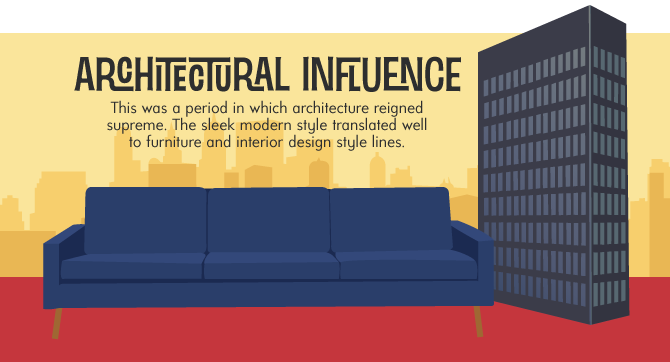
Urban city cores emptied out and people headed to the suburbs. Dense East Coast population centers migrated westward.
Frank Lloyd Wright‘s decades-old Prairie Style finally percolated down to the masses and saw fruition in the form of wide, low, and very horizontal Ranch and Rambler homes.
Horizontality is found in the desert as well, with its long, flat landscapes interrupted by few obstacles.
Desert communities such as Phoenix, Scottsdale, Palm Springs, and Tucson burgeoned under the influx of émigrés seeking not just sun but room to live: open spaces where a person could breathe.
It was a grand idea – in theory, at least. But by the 1970s, Modern had begun to flat-line.
Death and Rebirth of Modern Style
In 1981, things reached such a low point for Modern style that novelist and social commentator Tom Wolfe declared it “exhausted, finished.”
He considered the Modern style to be soul-less, dictatorial, cold.
He wrote of architect-designed summer houses that looked like “insecticide refineries” and schools that resembled “duplicating machine replacement parts…warehouses.” Wolfe, Tom. From Bauhaus To Our House. 1981.
Architect Michael Graves designed the whimsical Portland Building in 1982 and it was branded one of the very first post-modern buildings in the U.S. http://www.planetizen.com/node/66791 With that prefix of post-, it was clear Modern style was dead.
Mad Men show creator Matthew Weiner, long a closet fan of Modern, was acutely aware of this. He says “When I finished the [spec] script in 1999, there was still this feeling that mid-century was bad.” http://www.interiordesign.net/projects/detail/2343-welcome-to-1969-mad-mens-award-winning-set-design/
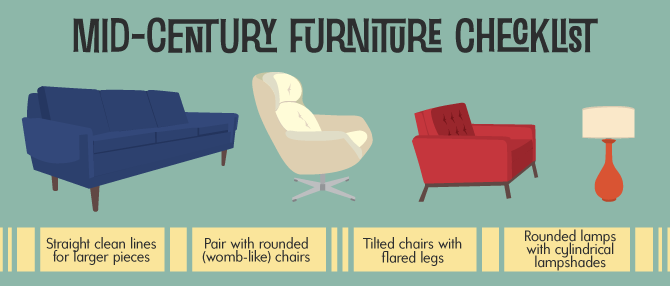
A Certain Kind of Style
Almost as soon as it aired, Mad Men fueled a red-hot madness for vintage-anything: clothing, cars, food, and cocktails.
Every hipster tossing back “artisanal” martinis would not be doing so if not for the influence of the series.
The show‘s eight-year run dropped several home décor styles upon us, though not all deserve to be remembered and maintained.
Flip through any period Better Homes and Gardens and you will come across styles that burst into existence, burned for all of five seconds, and then disappeared forever.
One reason why some home styles are relegated to the dustbin of history is because they were misbegotten in the first place.
You may find a few eccentrics who love the Knotty Pine Kitchen: twee and cheaply built pine cabinets dressed up with loads of varnish and frosted with faux-Swiss cutouts and trim.
As prevalent as this style was in the 1960s, you will find few homeowners today duplicating that style.
Weiner notes that, in the process of developing the show, he learned that period home styles were rigidly demarcated;
to his surprise, he found out that there was both an East Coast and a West Coast version of the mid-century Danish Modern style.4
It is no mistake that the most-favored Mad Men home style is not Don and Betty Draper‘s 1960-era Ossining, N.Y., house with its blue palette, fake shutters, plaid wallpaper, metal-edged Formica counters, and, yes, knotty pine cabinets.
The style that captures our imagination is Don and Megan Draper‘s swanky, upscale, cool mid-1960s Manhattan apartment, so of-the-moment that it is furnished with a refrigerator from the 1964 New York World‘s Fair.
Weiner says that the Draper apartment, designed by set decorator Claudette Didul, is his favorite in the series. He comments, “(The space) satisfies a lot of my fantasies.
It‘s very sexy. There‘s texture, wood. It‘s open, but you feel protected. It‘s very cosmopolitan. You feel smart there. You feel handsome.” 4
Turn Your House into a Mid-Century Modern Showcase
Think of your house as a set and yourself as a set designer. Begin with the more complex elements and work towards the easier, simpler ones:
Knock Down a Wall
For centuries, kitchens were kept separate from living quarters because theory dictated it was more prudent to keep this smoke-filled “workshop” away from cleaner living areas.
It was thought that a woman‘s place was in the kitchen.
Socially, the 1960s were all about knocking down walls: racial and gender barriers came crashing down.
Physical walls fell, too. Soon, many suburban homes were designed around the open floor plan. Kitchen, dining rooms, and living areas all flowed together when walls were removed.
Load-bearing interior walls carry the weight of floors or the roof above.
They can be removed only when replaced by load-carrying beams, a difficult project that requires the intercession of a contractor and structural engineer.
But few homeowners are aware that many interior walls are non-load-bearing and thus can be removed. Ample information is available online for methods that help you detect which walls carry weight and which do not.
For instance, when a wall runs parallel to the joists above, it is generally not load-bearing.
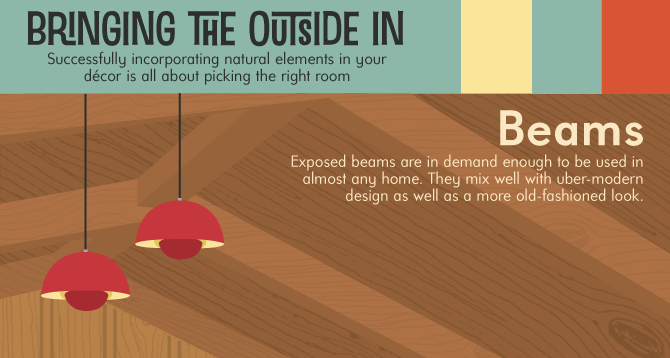
Expose Those Beams
Modernists loved to show the underlying structure of buildings.
The king of all Modernists, architect Mies van der Rohe, designed his famed Lakeshore Drive Chicago apartments to expose parts of the steel beam structure.
Exposed interior wood beams play off that desire for structural honesty. It is inadvisable to peel back your ceiling drywall to expose beams, as you will not achieve the desired effect.
Structural beams originally meant to be hidden should stay hidden.
Instead, faux ceiling beams made of high-density polyurethane look incredibly like real wood, since they are cast from molds created from real wood.
Manufacturers have improved the polyurethane mix so it perfectly duplicates wood‘s exact colors.
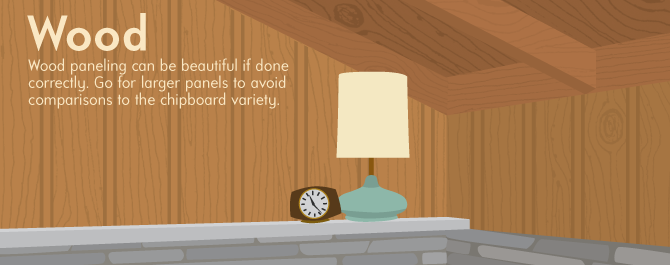
Bring on the Wood Paneling
The words “wood paneling” may evoke thoughts of cut-rate paneling in rec rooms with ping pong tables. Regular department-store wood paneling deservedly got a bad rap: it was awful stuff.
But the wood paneling you see gracing the Draper Manhattan apartment is sleek hardwood, not vinyl laminate atop chip board.
You can purchase and self-install paneling veneered in exotic hardwoods such as wenge, mahogany, zebrawood, or teak. These panels come in sizes that are easy to handle, ranging from two by four feet to three by six feet.
With so-called invisible fasteners, they easily attach edge-to-edge. Veneer-wrapped edges mean you do not have to hide the edges as you must with the cheap chipboard variety.
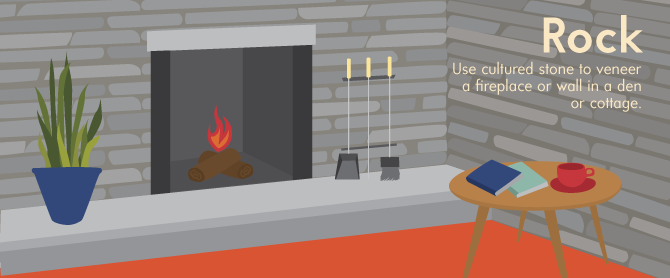
Rockscaping
“Bring the outside in” has been the goal of many architects over the years, and the 1960s saw this in full force when natural stonework began to enter the home.
Partially this is the influence of the desert, a place where flagstone is found in abundance.
Building with real stone is tough and is best left in the hands of stone masons.
But an acceptable substitute called “manufactured veneer stone” (or even more euphemistically, “cultured stone”) is a mixture of Portland cement, expanded aggregate, and binding resins.
Thirty percent lighter than real stone and with pieces designed to interlock, it is easy work for a do-it-yourselfer to veneer a fireplace, den or living room wall, or home exterior.
Period Windows
Windows are a big-ticket item, so you should not change them out solely to achieve a Modern style.
But if you are already in need of new windows, you might be pleased to know that window manufacturers have wised up to the fact that consumer-grade windows should architecturally match the home.
Andersen produces windows specifically for homes that aim to revive or maintain the Modern style. “Simple geometry, clean lines and the overt abandonment of architectural ornamentation characterize Modernism,” says Andersen.http://www.andersenwindows.com/home-styles/modern
In keeping with that edict, Andersen‘s casement windows emphasize clean vertical rectangles and eschew all unnecessary ornaments.
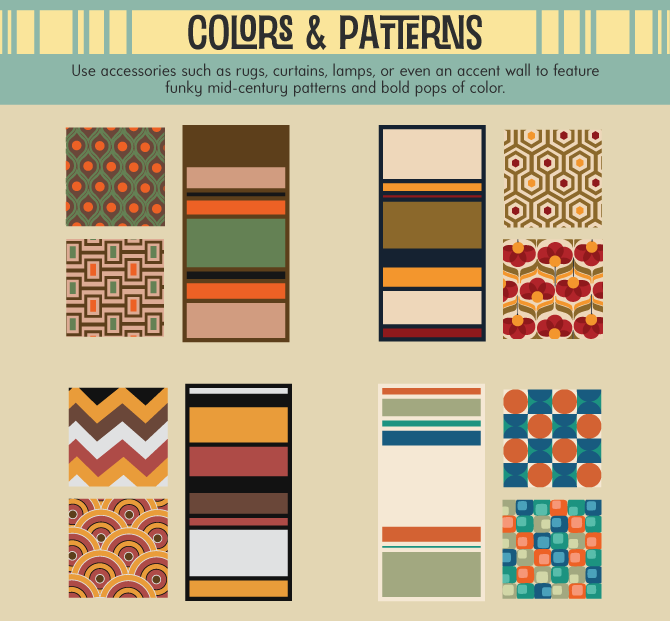
Furniture and Color That Make the Room
Low-and-flat is the order of the day with any Modern-style sofa. Sofas in Don and Megan Draper‘s apartment are so low you could almost miss them as you scan the room.
Sofas in the Wells Collection at Room & Board are low, long, angular, and rectangular. You will find barely a curve in these harshly geometric beauties.http://www.roomandboard.com/catalog/living/sofas/wells-leather-sofas
Be sure to go bold with colors, too. By the mid 1960s, pastels were passé, a sickening reminder of too-cheery Eisenhower America.
Homes were dominated by colors that were rich, vibrant, and earthy.
Paint manufacturer Sherwin-Williams says “avocado green, burnt orange, cherry red, sage or copper” are the little “pops” that show against Mad Men‘s restrained backdrops of black, white, or smoky gray.
http://www.sherwin-williams.com/architects-specifiers-designers/inspiration/project-profiles/residential/sw-art-stir-madmeninf.html The best thing about designing with color is that most paint retailers can mix and match any color you show them.
Get Started
Renovating in a vintage style may seem intimidating, but take comfort in knowing you are covering ground that is already tested, tried, and true.
Mad Men-style remodeling means emphasizing:
- Good, solid shapes, such as rectangles and squares
- Underlying structural elements
- Bold colors
- Sleek, sophisticated wood and rugged stone
Embed the article on your site

